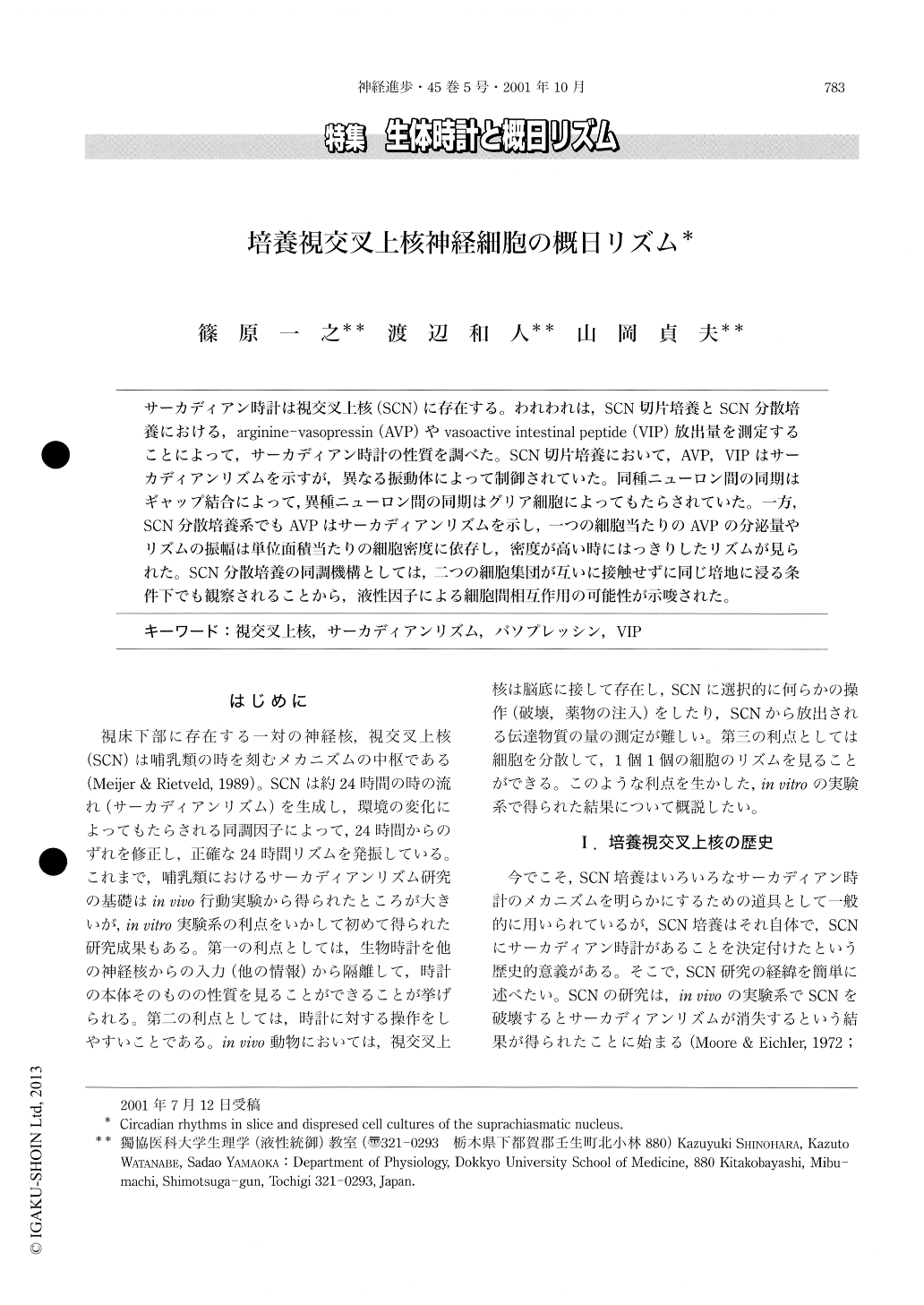Japanese
English
- 有料閲覧
- Abstract 文献概要
- 1ページ目 Look Inside
サーカディアン時計は視交叉上核(SCN)に存在する。われわれは,SCN切片培養とSCN分散培養における,arginine-vasopressin(AVP)やvasoactive intestinal peptide(VIP)放出量を測定することによって,サーカディアン時計の性質を調べた。SCN切片培養において,AVP,VIPはサーカディアンリズムを示すが,異なる振動体によって制御されていた。同種ニューロン間の同期はギャップ結合によって,異種ニューロン間の同期はグリア細胞によってもたらされていた。一方,SCN分散培養系でもAVPはサーカディアンリズムを示し,一つの細胞当たりのAVPの分泌量やリズムの振幅は単位面積当たりの細胞密度に依存し,密度が高い時にはっきりしたリズムが見られた。SCN分散培養の同調機構としては,二つの細胞集団が互いに接触せずに同じ培地に浸る条件下でも観察されることから,液性因子による細胞間相圧作用の可能性が示唆された。
The suprachiasmatic nucleus (SCN) of the hypothalamus comprises the primary pacemaker responsible for the generation of circadian rhythms in mammals. Individual SCN neurons have been suggested to be autonomous, single cell circadian oscillators. Intercellular communication that maintains synchrony within the population of the oscillators must occur, since the free-running periods of the individual oscillators are not identical in the SCN.
We found that two subpopulations of neurons that produce neuropeptides arginine-vasopressin (AVP) and vasoactive intestinal peptide (VIP) are synchronized in SCN slice cultures and that preventing glial proliferation by antimitotics results in desynchronization of the two subpopulations. This finding indicates that astrocyte networks are required for the coupling of two subpopulations in the SCN, but circadian rhythmicity in each subpopulation is still maintained after inhibiting glial proliferation, suggesting that different mechanisms underlie the intercellular synchronization within each subpopulation.
When a gap junction permeable dye, Lucifer Yellow, was injected into single neurons in the SCN culture, the dye was transferred to neighboring cells in a gap-junction-blocker sensitive manner. Optical imaging of neural activity evoked by electrical stimulation in the culture revealed that the spread of depolarization was inhibited by gap junction blockers but not by a blocker of voltage-dependent Na+ -channels. The gap junction blockers also disrupted circadian rhythmicity in the release of arginine-vasopressin (AVP) and vasoactive intestinal polypeptide (VIP). These independent lines of evidence indicate that gap junction channels exist between neurons in the SCN slice culture and suggest that the gap junction communication is involved in intercellular coupling within each sub-population of AVP or VIP neurons in the SCN.
Dissociated SCN cells also show circadian oscillation of AVP release in culture. The rhythm is clear at higher plating cell density. Although glutamate, a main transmitter of the retinohypothalamic tract, did not induced any phase shift of AVP rhythm in cell culture, VIP induced phase shift which resembles to that induced by the light pulse in vivo. The results suggest that individual AVP releasing cells contain circadian oscillators whose rhythms are mutually synchronized in culture. VIP directly resets AVP rhythm but glutamate has no such effect presumably because in vivo it acts through the VIP-ergic cells but the neuronal network is altered after the dissociation of the cells.

Copyright © 2001, Igaku-Shoin Ltd. All rights reserved.


